Single Event Effect Proton & Heavy Ion Test Results ... - NEPP - Nasa
Single Event Effect Proton & Heavy Ion Test Results ... - NEPP - Nasa
Single Event Effect Proton & Heavy Ion Test Results ... - NEPP - Nasa
Create successful ePaper yourself
Turn your PDF publications into a flip-book with our unique Google optimized e-Paper software.
SINGLE EVENT EFFECT PROTON AND HEAVY ION TEST RESULTS IN SUPPORT OF<br />
CANDIDATE NASA PROGRAMS<br />
K. LaBel, A. Moran, D. Hawkins, A. Sanders<br />
NASA/Goddard Space Flight Center, Code 735.1<br />
Greenbelt, MD 20771<br />
C. Seidleck<br />
Hughes/ST Systems Corporation<br />
Greenbelt, MD 20771<br />
H. Kim, J. Forney<br />
Jackson and Tull<br />
Greenbelt, MD 20771<br />
E.G. Stassinopoulos<br />
NASA/Goddard Space Flight Center, Code 900<br />
Greenbelt, MD 20771<br />
P. Marshall<br />
NRL/SFA, Washington, D.C.<br />
C. Dale<br />
NRL, Washington, D.C.<br />
R. Barry<br />
NASA/Goddard Space Flight Center, Code 734<br />
Greenbelt, MD 20771<br />
Abstract<br />
We present proton and heavy ion single event effect (SEE) ground test results for candidate<br />
spacecraft electronics. The variety of analog and digital devices tested includes ADCs, DC-DC<br />
converters, DRAMs, linear devices, and microprocessors.<br />
I. Introduction<br />
As spacecraft and spacecraft designers increasingly utilize increasing number of commercial<br />
technology devices versus the more traditional radiation hardened (RH) components in order to<br />
meet stringent spacecraft requirements in such areas as volume, weight, power, cost and<br />
schedule, SEE ground testing has become a key in many spaceflight programs.<br />
The objective of this study was to determine the Linear Energy Transfer (LET) threshold (the<br />
minimum LET value to cause an effect at a fluence of 1E7 particles/cm2) and saturation cross<br />
section of candidate spacecraft electronics for <strong>Single</strong> <strong>Event</strong> Upset (SEU) and latchup (SEL) due
to protons and heavy ions.<br />
A. <strong>Heavy</strong> <strong>Ion</strong> <strong>Test</strong> Facility<br />
II. <strong>Test</strong> Techniques and Setup<br />
The test facility used for heavy ion experiments was the Brookhaven National Laboratories<br />
(BNL) <strong>Single</strong> <strong>Event</strong> Upset <strong>Test</strong> Facility (SEUTF). The SEUTF utilizes a tandem Tandem Van<br />
De Graaf accelerator suitable for providing various ions and energies. <strong>Test</strong> boards containing the<br />
device under test (DUT) are mounted inside the vacuum chamber.<br />
<strong>Ion</strong>s used are listed in Table 1. Intermediate LETs were obtained by changing the angle of<br />
incidence of the DUT to the ion beam, thus changing the path length of the ion through the DUT.<br />
Table 1 <strong>Test</strong> <strong>Ion</strong>s<br />
<strong>Ion</strong> Energy, MeV LET, MeV*cm2/mg<br />
Cl-12 98 1.45<br />
F-19 140 3.45<br />
Cl-35 211 11.5<br />
Ni-58 263 26.7<br />
I-127 320 59.7<br />
Au-197 341 181.9<br />
Energies and LETs are nominal due to slight variances in the beam at multiple test dates during<br />
the calendar year. Particle fluxes for heavy ions were typically 1E3 - 1E5 particles/cm2.<br />
B. <strong>Proton</strong> <strong>Test</strong> Facility<br />
The test facility utilized for proton SEE testing was the University of California at Davis (UCD)<br />
cyclotron facility. <strong>Proton</strong> energies and fluxes were measured as those incident on the DUT<br />
package. <strong>Test</strong> energies ranged from 22 to 63 MeV incident upon the test device.<br />
C. <strong>Test</strong> Method<br />
Three modes of testing were used, depending on the DUT:<br />
static load device prior to beam irradiation, then retrieve<br />
data post-run counting errors (transients or bit flips)<br />
dynamic actively exercise a DUT during beam exposure while<br />
counting errors<br />
biased (SEL only) DUT is biased and clocked while Icc (power<br />
consumption) is monitored for SEL<br />
All tests were performed at room temperature.<br />
III. <strong>Test</strong> <strong>Results</strong><br />
A summary of devices and test results is seen in Table 3, following the paper.<br />
<strong>Results</strong> and Discussion<br />
Devices underwent full SEU/SEL characterization for heavy-ion only, unless otherwise stated.
A. FPGAs (Field Programmable Gate Arrays)<br />
1. A1280A FPGA<br />
The original objectives defined for this test were as follows<br />
Mode 0: examines input buffer and serial shift register<br />
Mode 1: examines output buffer and clock line<br />
Each mode was to be tested with three patterns (all 1s, all 0s, and a checked pattern). During<br />
previous testing, this device displayed no clock dependency. However, Mode 0 was shown to<br />
be more SEU susceptible when the checked pattern was used. Examining this tendency was<br />
to be the main objective in this test. At 1 MHz, in Mode 0, with a checked pattern, this device<br />
drew a current of >40mA (as opposed to
Nominal Vcc was ñ12V at +4/-17mA. SEL current was set at +5mA/-20mA. The device was<br />
operated with an up-counter input for an analog sawtooth output. An SEU was defined as a<br />
difference of 0.5V or greater between DUT and a reference device. Under these test<br />
conditions, no SEUs or SEL were seen up to a maximum tested LET of 80. It is expected that<br />
transient errors of less than 0.5V may occur from heavy ions.<br />
3. HS5212 12 bit ADC (Analog-to-Digital Converter)<br />
For this test, the device's digital output was compared to an expected value. Any difference in<br />
the 7 most significant bits of output, equivalent to 160 mV at device input, was counted as an<br />
SEU. Noise in the test setup prevented higher resolution. LETth for zero upsets is ~ 1.44. The<br />
maximum device cross section is ~ 1.0E-3 cm2. The SEL LETth is > 80 at a cross section of<br />
< 1E-7 cm2.<br />
4. 7820RP/372 8 bit ADC<br />
This device was tested for SEL only. During irradiation, this device was supplied with +5V<br />
and a nominal Icc of 6mA, with latchup current set at 20mA. No SEL was seen at the highest<br />
tested LET. Therefore, the SEL LETth is > 80, with cross section 50mA was counted as an SEU. Icc was a nominal 6mA with latchup current set at<br />
8mA. SEU LETth was found to be ~ 3.5 with a maximum cross section of 1.9E-2<br />
cm2/device. The device did not latch up for LET values up to 80.<br />
Figure 1 shows device SEU cross section for several analog devices tested.<br />
D. Power Devices [2]<br />
1. SSP-21110-025 solid state power controller (SSPC)<br />
The SSPC can be broken into two parts; a control section and a power section. The control<br />
section consists of densely populated proprietary ASICs and surface mount passive<br />
components. The ASICs are fabricated using bipolar technology. Control section operation<br />
was monitored by strip chart recorder, high-speed oscilloscope, and current limit checking,<br />
with no failures for LETs up to 80. The power section of the SSPC, consisting primarily of a<br />
number of NMOS power MOSFETs, was considered more susceptible to single event<br />
snapback (SES), single event burnout (SEB), and single event gate rupture (SEGR). <strong>Test</strong>ing<br />
for SEB included operation of the devices with a highly capacitive source at maximum<br />
normal bus voltage (35V), maximum PPL derated current (19A), and angles of the ion beam<br />
ranging from normal to 22 degrees, while checking for uncommanded mode changes and
glitches in both static modes. No SEE, power or control, was detected for the devices for<br />
LETs up to 80 at a fluence of 1E7.<br />
2. DC-DC Power Converters<br />
The following six DC-DC power converters were all tested using the same test setup. Due to<br />
the constrictions of the beam diameter, the top and bottom portions of these devices were<br />
irradiated separately.<br />
During irradiation, the DUT was operated in-step with a reference device while monitoring<br />
for four types of SEU. Steady state or level errors were discrepancies between reference and<br />
DUT outputs lasting longer than 1 microsecond. Glitch or transient errors were discrepancies<br />
between reference and DUT outputs lasting less than 1 microsecond. Destructive errors were<br />
indicated by high current conditions (SEL) and <strong>Single</strong> <strong>Event</strong> Gate Rupture (SEGR).<br />
Functional errors were device specific.<br />
a. AHE2815 DC-DC power converter<br />
This DC-DC power converter was tested with both normal input: 28V, 350mA (outputs 15V,<br />
375mA), and also with 34V, 272mA input. Both glitch and steady state errors occurred, with<br />
an SEU LETth between 20 and 26. "Switchoff" errors sent the device into a non-functional<br />
mode, and required a power reset for the device to again function normally. This condition<br />
had an LETth between 20 and 26. The SEU LETth for PM errors was between 20 and 26.6.<br />
SEGR was seen at an LET of 59.6 on a single DUT sample with 28V input, and in another<br />
device at an LET of 26.6 with 34V input, but was not seen on other DUTs.<br />
Figure 2 compares device SEU cross sections for the different types of SEU observed.<br />
b. 2690R-D15F DC-DC power converter<br />
This DC-DC power converter was tested both with nominal input 28V, 175mA (outputs 15V,<br />
300mA), and also with 34V, 149mA input. Glitch and steady-state errors were not<br />
monitored. A spontaneous power reset error occured with LETth between 4 and 8. DUT<br />
output would drop from a nominal 15V down to 0V and back to 15V, with a typical reset<br />
hysteresis curve and a pulse width of approximately 10 msec. No destructive conditions were<br />
seen on any sample for LETs up to a max tested of 72, even with 34V input.<br />
c. MFL2805S DC-DC power converter<br />
This device is a DC-DC power converter with nominal inputs of 28V at 125mA, with a<br />
single output of 5V. No transient output errors or destructive conditions were seen on this<br />
device type, at LETs up to a max tested of 72.<br />
d. MFL2812S DC-DC power converter<br />
This device is a DC-DC power converter with nominal inputs of 28V at 180mA, and output<br />
of 12V. Steady state errors occurred, with LETth ~ 50, but glitch errors were not seen.
Device cross section for the steady-state error was 5E-6 cm2/device. No destructive<br />
conditions were seen on any sample at LETs up to a max of 72.<br />
e. MFL2815D DC-DC power converter<br />
This DC-DC power converter was tested both with normal input 28V, 410mA (dual 15V<br />
outputs), and also with 34V, 360mA input. A special condition of a steady-state error<br />
occurred which required a power reset. The condition had an LETth between 45 and 59.7. No<br />
destructive conditions were seen on any sample at LETs up to a max tested of 72.<br />
f. MFL2815S DC-DC power converter<br />
This DC-DC power converter was tested both with normal input 28V, 240mA (single 15V<br />
output), and also with 34V, 230mA input. No transient errors or destructive conditions were<br />
seen on this device type, up to a max LET tested of 72.<br />
Figure 3 displays device SEU and SEL cross sections for several DC-DC Converters. Further<br />
information concerning SEE testing of these devices is available from LaBel, et.al. [2]<br />
E. Linear Devices<br />
1. LM119 Linear Comparator<br />
This device was tested for SEL only. During irradiation, the DUT was supplied with a Vcc of<br />
+5V, 4mA, with latchup current set at 10mA. No SEL was seen at the highest tested LET.<br />
Therefore, the SEL LETth is > 110, with cross section 100, with cross section < 1E-6 cm2/device.<br />
4. LM108 Op amp<br />
During testing, this device was operated in-step with a reference device. The device was<br />
supplied with ñ8V, with an operating current of 0.3mA. Latchup current was set at 0.6mA.<br />
The SEU LETth was ~ 24, with a maximum cross section of 5E-4 cm2/device. The SEL<br />
LETth was ~ 60. Note that only one sample of this device saw latchup, the other simply<br />
stopped functioning during testing at an LET of 60.<br />
5. LM124 Op amp
This device was tested for latchup only. The DUT was supplied with +5V, and had an<br />
operating current of 0.7mA. Latchup current was set at 1.2mA. This device was found to be<br />
latchup immune for LETs up to 90. During irradiation, small decreases in current were<br />
observed.<br />
6. LM158 Op amp<br />
This device was tested for SEL only. During irradiation, the DUT was supplied with a Vcc of<br />
ñ12V, ñ10mA, with latchup current set at ñ25mA. No SEL was seen at the highest tested<br />
LET. Therefore, the SEL LETth is > 100, with cross section 110, with cross section 100, with cross section 1E-4 cm2/device.<br />
None of the three device samples were functional post-irradiation.<br />
11. SE5521F Linear Signal Conditioner<br />
This device was tested for SEL only. During irradiation, the DUT was supplied with a Vcc of<br />
10V, 12.9mA, with a latchup current set at 18.0mA. No SEL was seen at the highest tested<br />
LET. Therefore, the SEL LETth is > 100, with cross section
This device was tested for SEL only. During irradiation, the DUT was supplied with a Vcc of<br />
+5V, 3mA, with latchup current set at 25mA. No SEL was seen at the highest tested LET.<br />
Therefore, the SEL LETth is > 110, with cross section 110, with cross section 110, with cross section 100, with cross section
During irradiation, this device was supplied with a Vcc of 5V, 18mA, with a latchup current<br />
of 100mA. It was operated with a checkerboard pattern input, in dynamic mode (read/write<br />
during irradiation) with a 2K refresh cycle. <strong>Test</strong> objectives were device characterization,<br />
gathering an angular data set, and identifying stuck bits and their addresses. Errors were seen<br />
at the initial LET of 1.46. The SEU LETth was < 1.46, with a cross section of 1.8E-7<br />
cm2/bit. No latchup, stuck bits or multiple upsets in a single word were seen at any time<br />
during testing.<br />
3. 16 Mbit (4Mbitx4) DRAMs<br />
The following six DRAMs were tested using the same setup. <strong>Test</strong>s used a checkerboard data<br />
pattern in Read/Modified Write mode; refresh cycle duration was device-dependent. Devices<br />
were run at a speed of 900 nsec. An SEU was defined as a noncompare in the data during the<br />
Read from one of the four data lines being monitored (one line for each 4MBit).<br />
a. 8116400-60PJ 16 Mbit Fujitsu DRAM<br />
This device was tested for both heavy ion and proton effects. <strong>Test</strong>s used a 4K refresh cycle<br />
(65.6 msec). Devices operated with a Vcc of 5V, 17mA. Latchup current was set at 100mA.<br />
During heavy-ion testing, the SEU LETth was found to be 80 with a cross section < 1E-7 cm2/device.<br />
Total dose failure was seen at > 30 kRad(Si).<br />
During proton testing, both lidded and delidded samples were tested. The two types of<br />
samples show little difference with the maximum cross section > 1E-7 cm2/device. Cross<br />
section showed a slight linear increase with energy, but no significant angular dependency.<br />
During total dose testing, significant permanent increases in device Icc were seen (from an<br />
original 17mA to 25mA at 38.4 kRad), while the device remained fully functional. Total dose<br />
failure was observed at ~ 42 kRad(Si), rendering the device inoperable, with device current<br />
of 50mA.<br />
b. HM5117400RR7 16 Mbit Hitachi DRAM<br />
This device was tested for proton effects only. <strong>Test</strong>s used a 2K refresh cycle (32 msec).<br />
Devices operated with a Vcc of 5V, 17mA. Only lidded samples were tested. The cross<br />
section shows a slight linear increase with energy to a maximum cross section of ~ 3.8E-7<br />
cm2/device. The device was total dose tested to ~ 50 kRad(Si), during which time permanent<br />
increases in device current were observed (from an original 17mA to 24mA at 50 kRad),<br />
while the device remained fully functional.<br />
c. MCM516400J60 16 Mbit Motorola DRAM<br />
This device was tested for proton effects only. <strong>Test</strong>s used a 4 K refresh cycle (65.6 msec).<br />
Devices operated with a Vcc of 5V, 17mA. Only lidded samples were tested. The cross
section increases slightly with energy to a maximum cross section of ~ 1.5E-6 cm2/device.<br />
This device has the same die as the Toshiba TC5117400FT-70, and the results are very<br />
similar.<br />
d. MCM517400J60 16 Mbit Motorola DRAM<br />
This device was tested for proton effects only. <strong>Test</strong>s used a 2K refresh cycle (32 msec).<br />
Devices operated with a Vcc of 5V, 17mA. Only lidded samples were tested. The test results<br />
were very similar to the Motorola MCM516400J60.<br />
e. MT4CM4B1DW 16 Mbit Micron DRAM<br />
<strong>Test</strong>s used a 2K refresh cycle (32 msec). Devices operated with a Vcc of 5V, 7mA. Latchup<br />
current was set at 80mA. The SEU LETth for this device is < 1.41. The SEL LETth lies<br />
between 12 - 26.6 with a maximum cross section > 2E-4 cm2/device.<br />
f. TC5117400FT-70 16 Mbit Toshiba DRAM<br />
This device was tested for both heavy ion and proton effects. Devices used a Vcc of 5V,<br />
17mA. Latchup current was set at 90mA. Cross section showed a slight linear increase with<br />
energy and a maximum cross section ~ 1.8E-6 cm2/device. The device was total dose tested<br />
to ~ 100 kRad(Si) and although permanent increases in device current were observed (from<br />
an original 18mA to 19mA at 100 kRad), the device remained fully functional.<br />
Figure 4 displays device SEU and SEL cross sections for several DRAMs tested.<br />
4. 70324L Dual Port RAM<br />
A single sample of this device was tested by NRL using a custom PC-based test setup. No<br />
SEL was seen at the highest tested LET (90), with a fluence of 5E7 particles/cm2. The<br />
device, however, appears fairly sensitive to SEUs.<br />
5. 70V25 16 bit Dual Port SRAM<br />
This device was tested in two modes:<br />
static - device was written to prior to irradiation and read after irradiation<br />
dynamic - device was written to/read from simultaneously during irradiation<br />
The device was tested with four patterns: all 1s, all 0s, checkerboard, and toggle (dynamic<br />
mode only). For the toggle pattern, the input was AC (as opposed to the other patterns in<br />
steady state), changing with the clock cycle.<br />
Though the static mode shows a slightly higher cross section, both modes displayed a similar<br />
SEU LETth of
latchup was seen for LETs up to 80. An equilibrium test was performed on the device in<br />
support of work by NRL. More information concerning this theory is available from article<br />
by Weatherford, et al.[3]<br />
G. FIFOs<br />
1. 7201T 512x9 Split Epi FIFOs<br />
These devices were tested using an all 1s pattern in Read/Write mode at a 50% duty cycle, at<br />
a frequency of 1 MHz. An SEU was defined as a noncompare in the data read. Normal<br />
operating current was 13mA, with monitoring for latchup conditions (maximum current<br />
28mA). The vendor provided special samples with varying epi thickness, each of which<br />
showed distinct SEE characteristics:<br />
12m This device experienced SEL at initial LET of 26.6<br />
10m This device experienced SEL at initial LET of 26.6<br />
8m This device had an SEL LETth between 50 - 60<br />
6m Device SEU LETth was < 3.36 with ssat ~ 5E-3<br />
cm2/device. SEL LETth was > 80 with ssat < 1E-6 cm2/device.<br />
The 6m device was also tested for proton effects, and were not easily upset by protons.<br />
During total dose testing, permanent significant increases in device current occurred (from an<br />
original 12mA to 27mA at 108 kRad), while the devices remained fully functional to > 100<br />
kRad(Si).<br />
Device SEU and SEL cross sections are displayed in Figure 5. Further information<br />
concerning testing is available from LaBel, et.al. [4]<br />
2. 7203ERP 9x2048 FIFO<br />
The devices were tested in dynamic mode (DUT being Write/Read continuously) at a 1 MHz<br />
frequency. Device Vcc was 5V, 13mA, with a latchup current of 30mA. <strong>Test</strong>ing was<br />
performed using an all 1s or an all 0s pattern. No statistical difference was seen between the<br />
two test patterns. An error was defined as a non-compare between output data values and<br />
expected data values on a bit basis. The SEU LETth is between 8 and 11.6. Due to the onset<br />
of SEL, no ssat was determined. The SEL LETth is 35. An additional error condition was<br />
also observed: large bursts of output errors were observed, most likely due to SEU hits to<br />
control areas of the DUT. This condition has an LETth of 20.<br />
3. 7203L40DB 9x2048k FIFO<br />
SEUs were defined as noncompares between DUT output and an expected pattern. <strong>Test</strong><br />
circuitry ran at 20 MHz, using a 5V supply with an operating current of 13mA. Latchup<br />
current was set at 120mA. The SEU LETth was ~ 3.4 with a maximum ssat of 5.5E-3<br />
cm2/device. The SEL LETth was between 15 - 22. During irradiation, regular current<br />
fluctuations (ñ1mA) were observed.
4. 7204 9x4096 FIFO<br />
The devices were tested in dynamic mode (DUT being Write/Read continuously), at a 1 MHz<br />
frequency. Vcc was 5V, 13mA with latchup current set at 30mA. <strong>Test</strong>ing was performed<br />
using an all 1s or an all 0s pattern. No statistical difference was seen between the two test<br />
patterns. An error was defined as a non-compare between output data values and expected<br />
data values on a bit basis. The SEU LETth is between 8 and 11.6. Due to the onset of SEL,<br />
no cross section was determined. The SEL LETth is 16.<br />
H. Microprocessors & Peripherals [5]<br />
1. 80386 Microprocessor<br />
The 80386, 80387, and 82380 were all tested using a single-board computer. Device was<br />
exercised using a software routine which performs addressing, memory reads and writes, and<br />
other operations. External clock speed was 16 MHZ. Failure of the device to write to a test<br />
address, incorrect data, or device lock-up was counted as an SEU. If lockup occurred, the test<br />
run was halted, and a reset was issued to the device. Figure 6 displays SEU and SEL device<br />
cross sections for 80386 tests.<br />
a. MG80386-20/B<br />
The SEU LETth is ~ 3.38. Traditional SEL (Icc > maximum for the device) was not seen on<br />
any test run. However, microlatch, a self-limiting latchup localized to an area of the device,<br />
was observed. With microlatch, Icc < the maximum for the device, but the device requires a<br />
power reset to reboot. The LETth for microlatch was between 37.1 and 59.9.<br />
b. 80386DX-25<br />
This device was tested for SEL only. Microlatch threshold was between LET 29 and 37.8.<br />
Devices were tested at both 5V and 5.25V.<br />
2. MG80387-20/B Math Coprocessor<br />
The 80387 test software was continually performing mathematical operations and checking<br />
for incorrect calculations. Incorrect data or device lock-up was counted as an SEU. If lockup<br />
occurred, the test run was halted, and a reset was issued to the device. SEU LETth for the<br />
80387 was 3.38. A stuck bit was seen twice during the test, but was cleared both times by a<br />
soft reset. Lockup was first observed at an LET of 26.2. LETth for traditional SEL was<br />
between 37.1 and 59.9. Microlatch was not observed.<br />
3. 82380 Integrated Peripheral<br />
The 82380 test software was continually performing memory accesses and transfers.<br />
Incorrect or incomplete accesses or data, unexpected interrupts, and device lockup were all<br />
counted as SEUs. If lockup occurred, the test run was halted, and a reset was issued to the<br />
device.
a. 82380-20/B<br />
Device SEUs were seen at the lowest LET tested of 3.38.Traditional SEL threshold was<br />
between 12.2 and 26.2. The 82380 also experienced possible microlatch conditions as well.<br />
b. 82380-16<br />
This device was tested for SEL only. Traditional latchup was observed at the lowest LET<br />
tested of 12. A dwell test was performed, allowing the device to operate for two minutes at a<br />
higher SEL current (2850 mA). The 82380 recovered fully, following a power reset.<br />
The 82380 experienced several unusual effects. In several tests, the operating current jumped<br />
above device rated limits, but the condition was cleared completely by a soft reset; power<br />
reset was not required, so the event was not SEL. In another test, following SEL, the<br />
operating current decreased (by ~20 mA in 2 minutes) of its own accord.<br />
4. 80486 Microprocessor<br />
During irradiation, the 80486 was exercised using one of several software routines (System<br />
test, paging, coprocessor, external memory access, interrupts, or software performance).<br />
<strong>Test</strong>s were run both with and without cache. Clock speed was 25 MHz (50 MHz internal to<br />
the DX2 device). A failure of the device to write to a test address, or lockup, was defined as<br />
an SEU. A watchdog timer allowed the device 425 msec to complete the write before issuing<br />
a reset. Figure 7 displays 80486 SEU and SEL device cross sections.<br />
a. 80486DX-33<br />
With cache enabled, SEUs were seen at the lowest tested LET of 3.53; the LETth appears to<br />
be ~ 3. With cache disabled, SEUs were not seen at the lowest LET tested of 3.53; the LETth<br />
is between 3.83 and 8.27, and appears to be around 5-6. In general, the more "cacheintensive"<br />
programs showed a higher SEU sensitivity. This device saw traditional destructive<br />
single events (Icc > than maximum specified for the device) starting at an LET of 20. Two<br />
(of two) samples of this device failed after occurrence of SEL.<br />
b. 486DX2-66<br />
SEUs were not seen at the lowest LET tested of 3.53, either with or without cache enabled.<br />
The SEU LETth is between 3.83 and 8.27 and appears to be ~ 5-6 in either case. This device<br />
saw a mix of microlatch and traditional SEL conditions, starting at an LET of 59.6. It should<br />
be noted that only one sample saw SEL at an LET of 59.6, and not all runs with LET > 59.6<br />
saw SEL; the other two samples did not see SEL until an LET >80. No device failures were<br />
seen post any SEL event. Total dose exposure was near 20 kRad(Si) for these samples.<br />
More information concerning the testing of the 80486 and the 80386 set is available from<br />
Moran,et. al. [5].<br />
I. Other
1. 49C460 EDAC controller<br />
Vcc for this device was 5V, 4mA with latchup current set at 10mA. The device was tested in<br />
normal operational mode (memory scrub) at a frequency of 1 MHz. The test pattern used was<br />
a checkerboard with one bit error (either 1-to-0 or 0-to-1) inserted. The operation flowed as<br />
follows:<br />
- data always has a single bit error<br />
- DUT corrects error<br />
- single bit error line is active, multiple bit error line is inactive<br />
- syndrome is formed<br />
Four typical error conditions were monitored during testing, plus a "special condition" and<br />
SEL. The standard error conditions were: data errors, syndrome errors, single bit error<br />
detection fail, and multiple bit errors in a word. The special condition was discovered during<br />
testing: Icc dropped to 1mA with continuous errors on all standard error lines. These errors<br />
continued even after the beam was stopped until a power reset was issued to the device. An<br />
SEU to the control region of the DUT is suspected, causing it to switch modes (possibly to a<br />
diagnostic mode).<br />
The LETth for the device is between 20-25, based on curve fitting. Control errors were seen<br />
sporadically starting with an LET of 26.6, but occurred infrequently enough to hinder<br />
statistical data collection for control error cross section. No sign of SEL was seen up to the<br />
highest LET tested (80).<br />
2. 74FCT163374 Dual 8 bit Register<br />
This device was tested by loading and verifying a checkerboard pattern at a speed of 1 MHz.<br />
An SEU was defined as a noncompare during pattern verification. The device was operated<br />
at a Vcc of 5V, 1mA.<br />
The SEU LETth was found to be ~ 20. However, the SEL LETth was ~ 25, with a maximum<br />
ssat > 5E-4 cm2/device.<br />
3. 74FCT163245 16 bit Bidirectional Transceiver<br />
This device was tested by loading a checkerboard pattern to the transmitter (side A) and<br />
verifying the output at the receiver (side B) at a speed of 1 MHz. An SEU was defined as a<br />
noncompare during pattern verification. The device was operated at 5V with a 1mA<br />
operating current.<br />
No SEUs were seen for LETs < 25.2. The SEL LETth was ~ 25.2 with a maximum cross<br />
section > 5.0E-4 cm2/device.<br />
4. HR2340 <strong>Test</strong> Metal Chip<br />
The HR2340 is a sea of transistors gate array, based on the RICMOS IV process. This device
was tested in support of the MONGOOSE III program, a commercially-compatible R3000based<br />
processor. There are many functions in this test chip of which, for SEE purposes, we<br />
tested the following:<br />
<strong>Test</strong> chip areas: register type # of stages or bits<br />
(soft latch JK 150<br />
design) D 200<br />
RS 150<br />
<strong>Test</strong> chip areas: 32x23 asynch RAM, 1Kx1 synch RAM<br />
(RH design)<br />
A custom test board used an 8051 microcontroller along with the DUTs and support logic on<br />
a PCB. This allowed a low-noise test setup, providing reliable results. <strong>Test</strong> results for soft<br />
latch areas (Xsections are per flip-flop):<br />
Mode, Pattern, Vcc LETth, MeV*cm2/mg cross section, cm2<br />
Dynamic, Mixed, 4.5V ~ 14 2E-6<br />
Dynamic, Mixed, 5V 16 2E-6<br />
Dynamic, All 0s, 5V 16 1.2E-6<br />
Dynamic, All 1's, 5V 16 1.2E-6<br />
Static Mixed, 5V ~ 19 8.4E-7<br />
<strong>Test</strong> conditions: Temperature 25 deg C<br />
Vcc for SEU 5V and 4.5 V<br />
Vcc for SEL 5.5V<br />
<strong>Test</strong> modes: Static device pre-loaded, then irradiated, then checked<br />
for errors post-beam<br />
Dynamic continuous Read/Write at a 1 MHz frequency<br />
<strong>Test</strong> patterns: all 0s, all 1s, and mixed 0s and 1s<br />
The soft latch areas are approximately 10-25% more sensitive using a mixed test pattern than<br />
an all 1s or 0s pattern.<br />
Figure 8 displays HR2340 SEU cross sections per flip-flop.<br />
IV. SUMMARY<br />
We typically divide SEE test results into the following four categories:<br />
Category 1 Recommended for usage in all spaceflight applications<br />
Category 2 Recommended for usage in spaceflight applications, but may require some SEE<br />
mitigation techniques<br />
Category 3 Recommended for usage in some spaceflight applications, but requires extensive<br />
SEE mitigation techniques or SEL recovery mode.<br />
Category 4 Not recommended for use in any spaceflight applications.<br />
Table 2 summarizes device recommendations.<br />
V. Acknowledgements
The authors would like to acknowledge the participating Goddard programs, namely the Far<br />
Ultraviolet Spectroscopic Explorer (FUSE), Tropical Rainfall Measuring Mission (TRMM),<br />
Hubble Space Telescope (HST), Landsat-7, NASA Headquarters/Code Q and CIRS. Special<br />
thanks to Naval Research Laboratory, and to the staff at Brookhaven National Laboratory<br />
SEUTF and University of California-Davis Cyclotron.<br />
VI. References<br />
[1] R. Katz, R. Barto, P. McKerracher, B. Carkhuff, and R. Koga, "SEU Hardening of Field<br />
Programmable Gate Arrays (FPGAs) for Space Applications and Device characterization,"<br />
IEEE Trans. Nuclear Science, vol. 41, page 2179, Dec. 1994.<br />
[2] K. LaBel, R. Barry, K. Castell, H. Kim, and C. Seidleck, "Implications of <strong>Single</strong> <strong>Event</strong><br />
<strong>Effect</strong> Characterization of Hybrid DC-DC Converters and a Solid State Power Converter,"<br />
submitted for publication in IEEE Transactions on Nuclear Science, Dec., 1995.<br />
[3] J. Cutchin, P. Marshall, T. Weatherford, J. Langworthy, E. Petersen, A. Campbell, S.<br />
Hanka, and A. Peczalski, "<strong>Heavy</strong> <strong>Ion</strong> and <strong>Proton</strong> Analysis of a GaAs C-HIGFET SRAM,"<br />
IEEE Trans. Nuclear Science, vol. 40, page 1660, Dec. 1993.<br />
[4] K. LaBel, P. Marshall, J. Kinnison, W. Stapor, "<strong>Single</strong> <strong>Event</strong> <strong>Effect</strong> Characteristics of<br />
CMOS Devices Employing Various Epi-layer Thicknesses," to be presented at RADECS'95,<br />
Arcachon, France, 1995.<br />
[5] A. Moran, K. LaBel, C. Seidleck, R. McGraw, M. Broida, J. Firer, and S. Sprehn, "<strong>Single</strong><br />
<strong>Event</strong> <strong>Effect</strong> <strong>Test</strong>ing of the Intel 80386 Family and the 80486 Microprocessor," to be<br />
presented at RADECS 95, Arcachon, France, 1995.


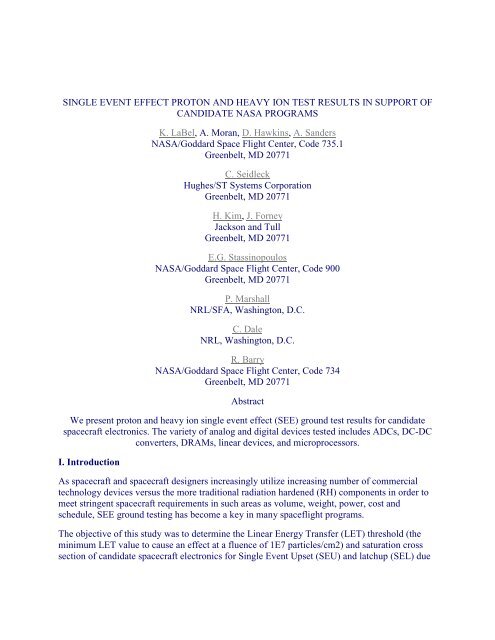
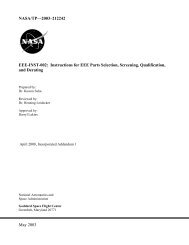

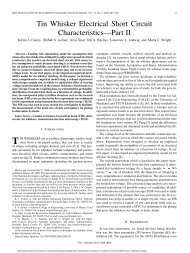
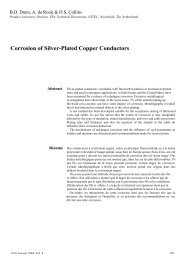
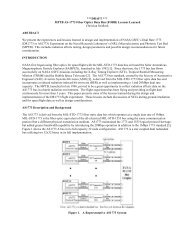

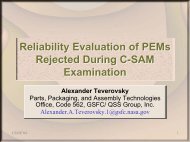
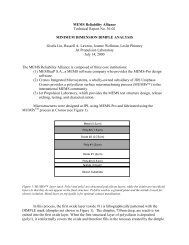
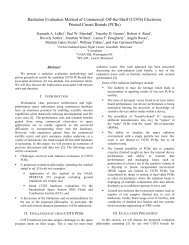
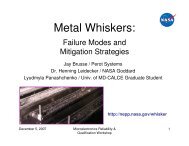
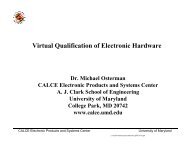
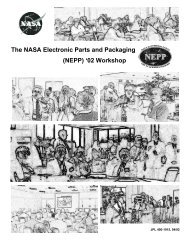
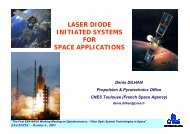
![mil-std-2223 [test methods for insulated electric wire] - NEPP](https://img.yumpu.com/4036001/1/190x249/mil-std-2223-test-methods-for-insulated-electric-wire-nepp.jpg?quality=85)